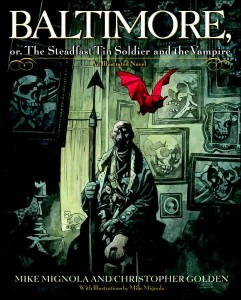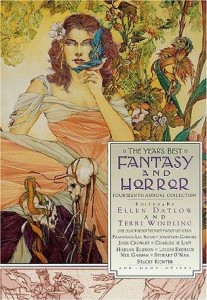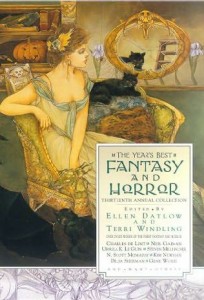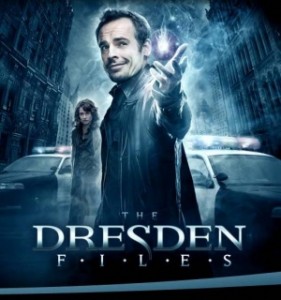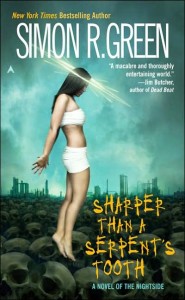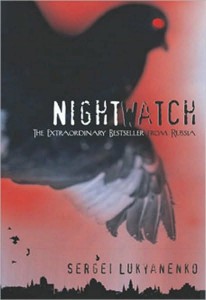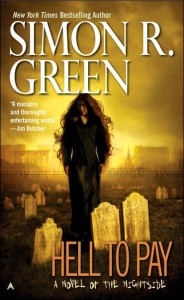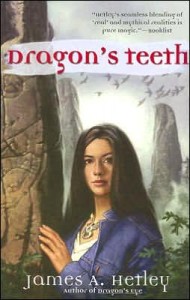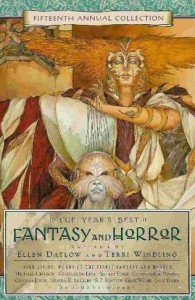 If someone were to assign awards to the roundup of Year’s Best books that invariably grace the shelves during the middle of each year, those volumes edited by Silverberg or Hartwell or Datlow and Windling or other sundry people, then it’s a sure bet the Datlow/Windling collection, now a most respectable fifteen volumes in strength, would be a shoo-in for the MVP award. Or perhaps Best In Show. And by that, I mean that while any collection can take a dozen or two dozen stories published in the previous year and assign them such qualities as to call them “the best,” only this particular collection goes above and beyond, nay, transcends duty with its accomplishments.
If someone were to assign awards to the roundup of Year’s Best books that invariably grace the shelves during the middle of each year, those volumes edited by Silverberg or Hartwell or Datlow and Windling or other sundry people, then it’s a sure bet the Datlow/Windling collection, now a most respectable fifteen volumes in strength, would be a shoo-in for the MVP award. Or perhaps Best In Show. And by that, I mean that while any collection can take a dozen or two dozen stories published in the previous year and assign them such qualities as to call them “the best,” only this particular collection goes above and beyond, nay, transcends duty with its accomplishments.
For therein lies the truth. Anyone can make up a Year’s Best list of stories. Tastes are subjective and personal enough that no one will agree with all of the stories all of the time. What one editor might consider worthy, another might dismiss. What one reader might devour, another might yawn at. Terri Windling has the right of it in this volume when she states, “Fantasy readers are the winners here, presented annually with the treasures provided by two anthologies, each covering somewhat different ground.” She wrote this in relation to the launch of the David Hartwell and Kathryn Cramer Year’s Best series, but it can just as easily be applied to the Robert Silverberg-edited volume, or even to the Gardner Duzois companion volume also released by St. Martin’s which covers the Year’s Best Science Fiction.
This lengthy introduction, thus, is my disclaimer: All stories collected henceforth in this volume are done so with an editorial bias, and may or may not be the best as you, or I, or anyone else, sees them. This is by no means a bad thing. Ellen Datlow and Terri Windling haven’t made it this far for no good reason. They are supremely skilled at sifting through anthologies, magazines, e-zines, journals, and publications both widespread and obscure, selecting rare treasures, hidden gems, overlooked works, and things that the average reader likely never saw in print the first time around. So to begin with, you’ll find any number of stories or poems for the first time within these pages.
Certain names are all but guaranteed to be in the table of contents. Charles de Lint is a mainstay of the series; this year, it’s his werewolf love story, “Trading Hearts at the Half Kaffe Cafe” that makes the cut, pulled from the anthology Single White Vampire Seeks Same . Maybe not one of his best ever, but a typically strong, enjoyable story nonetheless. Michael Chabon, best known for mainstream works like The Amazing Adventures of Cavalier and Klay, is represented with “The God of Dark Laughter”, taken from The New Yorker. Jane Yolen’s “The Barbarian and the Queen: Thirteen Views” is an oddly surreal piece first published in Starlight 3, edited by Patrick Nielsen Hayden. Ursula K. LeGuin’s “The Bones of the Earth” first appeared in her own collection, Tales from Earthsea. Tanya Huff’s “Oh, Glorious Sight” was first seen in the anthology Oceans of Magic. Meanwhile, Elizabeth Hand’s darkly erotic, oddly disturbing story, “Cleopatra Brimstone,” comes from the boundary-straining anthology, Redlight.
There’s more, much more. Gene Wolfe, Barry N. Malzberg, Graham Joyce and S.P. Somtow. Caitlin Kiernan, Gregory Maguire, Gala Blau, and Kelly Link. The stories come from SCIFI.COM, Interzone, The Magazine of Fantasy and Science Fiction, Lady Churchill’s Rosebud Wristlet, Strangehorizons.com, literary journals and poetry journals, anthologies and single-author collections, chapbooks and online magazines. They’re collected from genre publications, mainstream publications, and things that can’t even be classified. With dozens of authors and just as many works to choose from, running the gamut of fantasy and horror and the uncomfortable spaces overlapping between, there’s enough to please just about any tastes, even as one shakes his head and wonders what anyone ever saw in Story X. It’s certainly one of the biggest, most fascinating, most eclectic Year’s Bests out there, considering as it does so many different sources.
In honesty, the stories are almost like an afterthought compared to the prologue. Only a volume like this could dedicate five hundred pages to fiction, and another one hundred and twenty-some to summing up the year in general. It’s like the cream filling in an Oreo: the best part, one that can be savored on its own.
As always, Terri Windling produces a scholarly, extensively thorough look at the year in fantasy. From her opinions on the top twenty books (in alphabetical order), to note-worthy first novels, from imaginary world fantasy to contemporary fantasy, from historical to humorous, from mainstream to other genres, she looks at dozens of books, giving them each a brief blurb of commentary, honest to a fault. When she likes it, she’ll say so. When something needs improvement, it’s noted as well. She covers children’s fantasy (a new favorite sub-genre of mine), single-author collections, anthologies, magazines (on the bottom of page xxxvi, Green Man gets a blurb), art, picture books, nonfiction, folklore and fairy tales, music, and awards. Can I just say that this summary could double as a shopping list for any fantasy buff? It’s that extensive. I’m of a mind to go hunting.
Not to be outdone, Ellen Datlow tackles the subject of horror in 2001. Her lengthy essay covers every facet of horror, from books to magazines (my disappointment was in not seeing vampire magazine Dreams of Decadence get a nod), art to anthologies (and she was particularly, honestly, harsh on the quality and effectiveness of a few of these; my favorite quote, regarding Bubbas of the Apocalypse, was “hey, why don’t we put on a show in this ole barn and invite some of our friends?” I have this anthology. Ask nice, I may review it someday). Of particular usefulness is the listing of small press addresses she includes at the end of the summary.
Edward Bryant sums up the year in the media. His purview is “Media of the Fantastic,” meaning he looks at fantasy, horror, even science fiction as it pertains to permutations such as movies, television, and even toys. Again, useful. Again, thorough. By no means as comprehensive as the other essays, it still manages to give a pretty good look at how the field has been represented in live action, animation, and at the box office.
New to the Year’s Best series this year is famed artist Charles Vess, whose collaboration with Neil Gaiman produced Stardust, and whose four-issue comic book series The Book of Ballads and Sagas hasn’t gotten nearly enough attention. This, naturally, makes him ideal to review fantasy and horror in comics. To be honest, he cheats a little; not everything he mentions came out in 2001. In fact, he starts off with a brief history of the field as it applies to the genre, by way of orienting his readers. For a comic afficiendo like myself, this section is both enlightening (oh, that looks good) and frustrating (how the heck did I miss that?). Here’s hoping Vess sticks around for future volumes.
Also new to the series is noted author Joan D. Vinge, who tackles the twin topics of manga and anime, which have been enjoying a fast-growing popularity in America for some time now. (Between the Cartoon Network’s wholesale importing of series, and the Sailor Moon/Pokemon crazes, that popularity has become more of an obsession, in my opinion.) She’s kind enough to write her column as though to the uninitiated, starting off with a series of Frequently Asked Questions. Things like “Why do so many characters look like Americans?” and “What’s with all the T and A?” and “So about those delicate, beautiful young men…” So I paraphrased just a little. She’s very good at clueing in the newcomer, before launching into a discussion of what’s worthwhile, where to find it, and how to learn more about it. Anime and manga have irrevocably become part of the fantasy/horror/science fiction field, so it’s good to see a collection like this acknowledge the fact.
Finally, series packager and respected editor in his own right, James Frenkel, has the last word on the last words of those who’ve gone to the great convention in the sky, with the regular obituary column. Every year, the field loses a sobering number of those who were crucial, or related to it, and he pays his respects. In 2001, we saw the passings of Poul Anderson, Douglas Adams, William Hanna (of Hanna-Barbera animation fame), Gordon Dickson, Jenna Felice (a Tor Books editor who was much beloved by those who worked with her), Dan DeCarlo (best known for creating Josie and the Pussycats) and dozens more, from publishing, film, fandom, comics, and more. The scope of Frenkel’s attention on who is, was, and used to be part of the field in all its many manifestations is both impressive and disturbing; how many of these people have we even heard of today? But as he puts it, “Perhaps you’ll find inspiration in the works of those whose names aren’t familiar.”
After all that, at the end of the book, we have the Honorable Mentions, for those books and stories that were deemed worthy of mention, but which couldn’t be included for other reasons, such as space consideration. At 250,000 words, the book already weighs in fairly heavily. That Datlow and Windling take the time to list all these others is astounding.
Last but not least, I’d be remiss if I didn’t mention the typically gorgeous cover by Thomas Canty, who’s done quite a bit towards helping present the series as a uniform whole. The only problem I see with the covers he’s provided for each volume is that, after a while, they all start to look alike from a distance. But that’s a small price to pay for the exquisite job he does each year.
In the end, The Year’s Best Fantasy and Horror Fifteen is as strong as the rest in the series. Word for word, you get more for your money than any other Year’s Best collection on the shelf, with the assorted summaries being well worth the price just on their own merits. I recommend this book without hesitation, especially if you have any interest in the field beyond just reading stories.
Terri Windling has a Web site, The Endicott Studio, which Green Man highly urges you to check out. Charles Vess can be found at www.greenmanpress.com, which is another reason for us to like him. Ellen Datlow is currently the editor for Scifiction.com. You can check out the St. Martin’s Web site at www.stmartins.com . While our reviews of Datlow and Windling collections are too numerous to be mentioned here, you may access them all from our “authors” index page. Also see our interview with Terri Windling. Ellen Datlow has a most excellent Web site here.
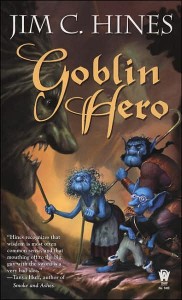 Jig the goblin is back, and this time he’s getting a little hell from his . . . well, goblins don’t have friends. Let’s call them allies. If allies are prone to stabbing you in the back, or shoving you down a well, or feeding you to a dragon. Yeah. Jig’s in trouble, as usual. He thought he could go back to a nice, quiet life after his last unwilling adventure, but he was wrong. Threatened by Jig’s newfound usefulness and ability to heal (courtesy of the not-so-forgotten god Tymalous Shadowstar), Kralk, the goblin chief, sends him on a “mission of mercy” to the rival ogres, who specifically requested Jig’s help. Seems they’re having trouble of the magical variety, and they need a Hero of the Jig sort. So off Jig goes, accompanied by Graf, a goblin almost too stupid to live, and Grell, who’s spent untold years caring for goblin young. Following them in secret is Veka, a would-be goblin Hero and her reluctant hobgoblin ally, Slash.
Jig the goblin is back, and this time he’s getting a little hell from his . . . well, goblins don’t have friends. Let’s call them allies. If allies are prone to stabbing you in the back, or shoving you down a well, or feeding you to a dragon. Yeah. Jig’s in trouble, as usual. He thought he could go back to a nice, quiet life after his last unwilling adventure, but he was wrong. Threatened by Jig’s newfound usefulness and ability to heal (courtesy of the not-so-forgotten god Tymalous Shadowstar), Kralk, the goblin chief, sends him on a “mission of mercy” to the rival ogres, who specifically requested Jig’s help. Seems they’re having trouble of the magical variety, and they need a Hero of the Jig sort. So off Jig goes, accompanied by Graf, a goblin almost too stupid to live, and Grell, who’s spent untold years caring for goblin young. Following them in secret is Veka, a would-be goblin Hero and her reluctant hobgoblin ally, Slash.
